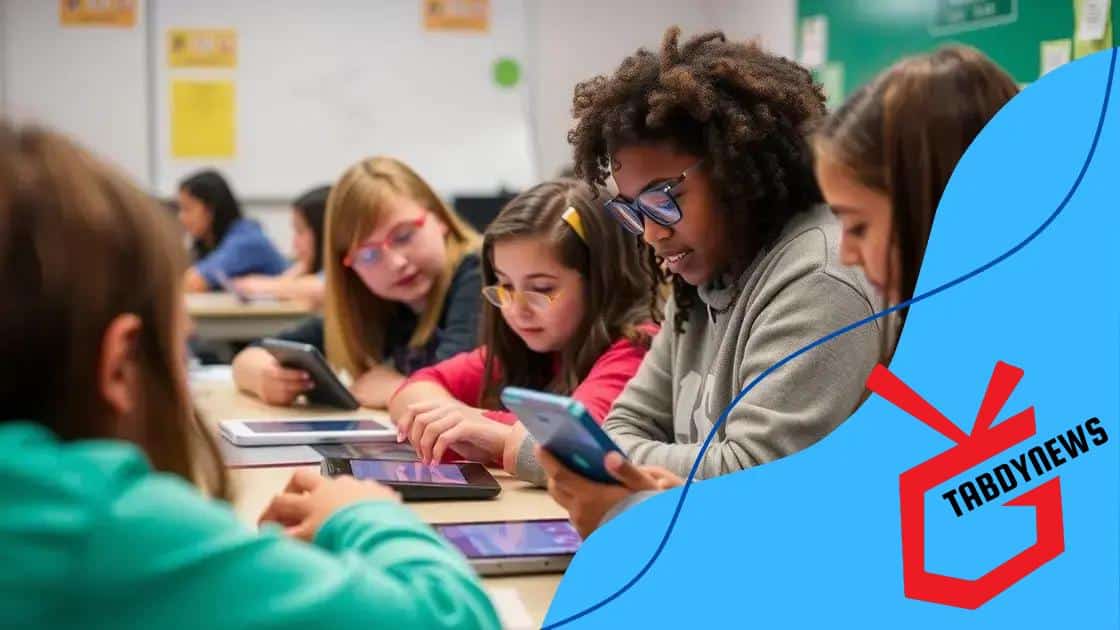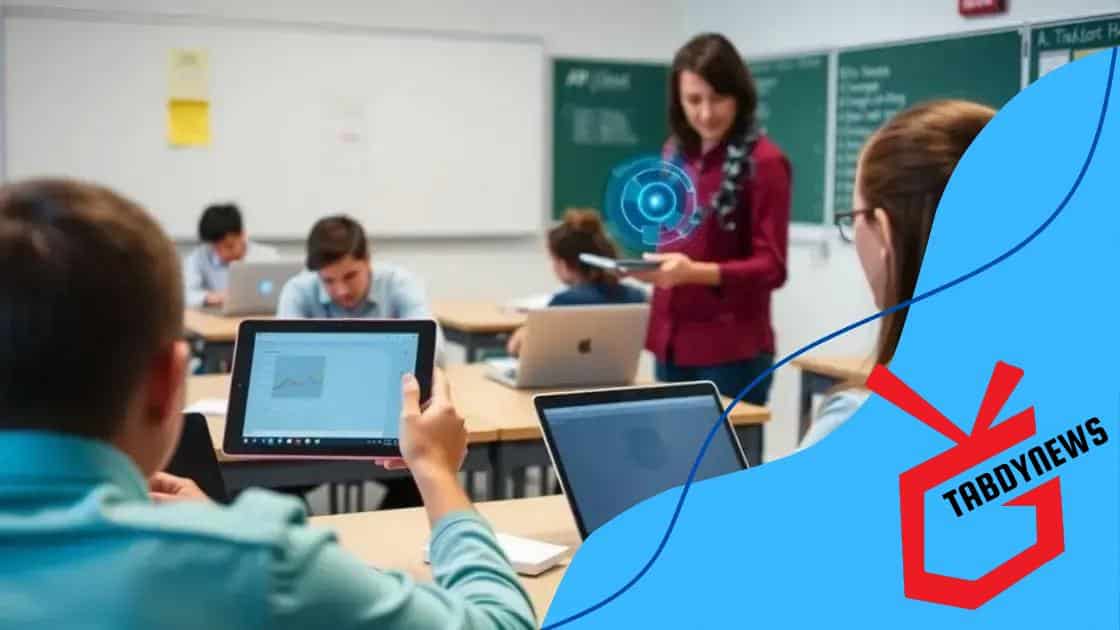AI tracking for student participation: enhance learning

AI tracking for student participation enhances engagement by providing real-time data insights, improving personalized learning experiences, and identifying individual student needs in educational settings.
AI tracking for student participation is changing how educators engage with learners. Ever wondered how technology can boost classroom dynamics? In this article, we’ll uncover the transformative impact of AI on student involvement.
Understanding AI tracking technology
Understanding AI tracking technology is essential for enhancing student engagement. This innovative tool helps educators monitor how students participate in real-time, offering insights that were once difficult to obtain. With AI, tracking becomes more than just a data collection process; it transforms education by enabling personalized learning experiences.
How AI Works in Tracking
AI tracking technology uses various methods to gather and analyze student participation. By employing algorithms, it collects data on interactions, participation rates, and even emotional responses to lessons. This detailed approach allows teachers to tailor their methods to meet each student’s needs effectively.
Key Features of AI Tracking Technology
- Real-time data analysis: Educators can see how students are reacting during lessons.
- Personalized feedback: AI systems can provide individualized recommendations based on student performance.
- Enhanced engagement metrics: Gain insights into what captivates student attention.
- Seamless integration: AI can integrate with existing classroom technologies for smooth implementation.
Moreover, this technology not only supports teachers but also empowers students. By understanding their learning patterns, students can adapt their study habits. They receive immediate feedback, helping them to address their weaknesses promptly.
As we delve deeper into the workings of AI tracking technology, it becomes clear that the benefits are profound. This technology mitigates the guesswork previously involved in teaching and learning, allowing for a more dynamic and responsive classroom environment. In the upcoming sections, we will explore the various benefits of AI tracking, showcasing its impact on student engagement and overall educational success.
Benefits of AI tracking for students
The benefits of AI tracking for students are numerous and impactful. This technology provides educators with a powerful tool to enhance the learning experience. By utilizing AI tracking, teachers gain invaluable insights into students’ engagement and performance, enabling them to address individual needs effectively.
Improved Personalization
One of the greatest advantages of AI tracking is its ability to personalize learning. Through data analysis, educators can identify areas where students struggle, allowing them to tailor lessons and resources accordingly. This ensures that each student receives the support they need to excel.
Enhanced Engagement
AI tracking also allows for improved engagement. Teachers can monitor participation levels in real-time, helping them to understand which activities capture students’ interest. By adjusting their teaching strategies based on this data, educators can create a more dynamic and engaging classroom environment.
- Immediate feedback: Students receive quick responses on their performance, aiding their learning process.
- Motivation boosts: Recognizing progress can encourage students to stay committed and engaged.
- Targeted interventions: Identifying struggling students helps teachers provide timely assistance.
Furthermore, AI tracking for students promotes accountability. When students know that their participation is being monitored, they are more likely to stay focused and be active during lessons. This sense of responsibility can positively influence their academic habits.
In addition, the technology fosters collaboration. By analyzing group interactions, educators can see how students work together. This information can be used to enhance group activities, ensuring that every student contributes and learns from each other. As educational methods continue to evolve, embracing AI tracking will greatly benefit both teaching and learning in today’s classrooms.
Implementing AI participation tracking in classrooms

Implementing AI participation tracking in classrooms is an effective way to enhance learning outcomes. This approach allows teachers to monitor student engagement continuously and adapt their strategies based on real-time data. Making this transition, however, requires thoughtful planning and execution.
Steps to Implement AI Tracking
The first step in implementing AI participation tracking is to select the right technology. Various platforms offer different features tailored for classroom use. It’s essential to evaluate these tools to find one that meets your needs. Next, integrating these tools into existing classroom systems is crucial for a smooth transition.
Key Factors to Consider
- User-friendly interface: Ensure that both teachers and students find the technology easy to use.
- Data security: It’s vital to prioritize student privacy and choose solutions that comply with regulations.
- Training for educators: Providing adequate training helps teachers use the technology effectively.
- Ongoing support: Choose a platform that offers reliable customer support to address any challenges that may arise.
After selecting a tool, it’s important to involve students in the process. Educating them about AI tracking can foster accepting and responsible use of the technology. When students understand its purpose and benefits, they are more likely to engage positively with it. Encouragement and regular discussions about their participation can enhance their experience.
Moreover, regular reviews of the data collected through AI tracking can help teachers make informed decisions. This feedback loop allows for adjustments in teaching methods and content delivery, making the learning process more dynamic. As teachers become more accustomed to using these tools, they can utilize insights to create customized learning plans for students.
Ultimately, incorporating AI participation tracking requires collaboration among educators, students, and parents. Engaging all stakeholders ensures a supportive environment for effective implementation, paving the way for improved educational experiences.
Challenges and solutions in AI tracking
The use of AI tracking in education brings many benefits, but it also presents several challenges that educators must navigate. Understanding these challenges is essential for effective implementation. Addressing these issues can lead to successful integration that enhances student learning.
Common Challenges
One major challenge is the concern over data privacy. Many educators worry about how student information is collected, stored, and used. Ensuring compliance with regulations, such as FERPA, is vital to protect student data. Another challenge is the resistance to change from both staff and students. Some individuals may prefer traditional methods of tracking engagement.
Identifying Solutions
- Implement strong data protection policies: Educators should work with IT professionals to develop a robust data security plan.
- Provide education and training: Offering workshops can help reduce resistance by showing the benefits of using AI tracking.
- Encourage feedback: Creating a feedback loop allows students and teachers to express their concerns or suggestions for improvements.
- Start small: Implementing AI tracking gradually can help ease the transition and allow the education team to adjust.
Moreover, technical issues can arise, including software glitches and integration problems. These can create frustration and hinder the effectiveness of the technology. Ongoing support is crucial for addressing these issues promptly and effectively. As educators adopt AI tracking, having access to technical assistance can assure smooth operation.
Finally, it’s essential to measure the impact of AI tracking on student engagement and learning outcomes. Collecting feedback and analyzing data will help determine whether the system is successful or needs adjustments. By addressing these challenges, educators can harness the full potential of AI tracking to create engaging, personalized learning experiences.
Future trends in AI education tracking
Future trends in AI education tracking are set to reshape the landscape of learning. As technology advances, we can expect more sophisticated and intuitive methods of tracking student engagement and performance. This evolution will significantly enhance how educators support their students.
Enhanced Data Analytics
One trend is the growth of enhanced data analytics. AI systems will be able to analyze vast amounts of data in real-time, providing insights that were previously unattainable. Teachers will receive more accurate assessments of student progress, allowing for quicker adjustments in teaching strategies.
Integration with Virtual and Augmented Reality
Another exciting development is the integration of AI tracking with virtual and augmented reality. This combination can create immersive learning environments where student participation can be monitored more effectively. Imagine a physics class where students experiment with virtual simulations, with AI tracking their engagement and comprehension levels.
- Real-time feedback: Students can receive instant responses on their participation, enhancing motivation.
- Adaptive learning paths: AI can suggest personalized learning experiences based on tracked data.
- Collaboration features: Future AI tools will enable better collaboration among students by tracking group dynamics.
Furthermore, as AI technology improves, concerns about data privacy will continue to evolve. Future trends will likely include more transparent systems that prioritize student confidentiality and security. Educational institutions will need to adopt guidelines that ensure responsible use of AI tracking data.
In addition, there will be a greater focus on inclusivity in AI tracking. Future systems will be designed to cater to diverse learning needs, ensuring all students benefit from tailored experiences. This approach will aid in creating equitable educational environments where every learner can thrive.
Overall, the future of AI education tracking promises exciting possibilities. By harnessing advanced technologies and fostering engagement, educators can pave the way for more effective and personalized learning experiences in the classroom.
FAQ – Questions about AI Tracking in Education
What are the main benefits of AI tracking for students?
AI tracking enhances student engagement by providing personalized learning experiences and immediate feedback on their performance.
What challenges do educators face when implementing AI tracking?
Challenges include data privacy concerns, resistance to change from staff and students, and technical issues during setup.
How can schools ensure data privacy when using AI tracking?
Schools can implement strong data protection policies and ensure compliance with regulations like FERPA to safeguard student information.
What future trends should we expect in AI education tracking?
Future trends include enhanced analytics, integration with virtual reality, and systems focused on inclusivity and personalized learning.





